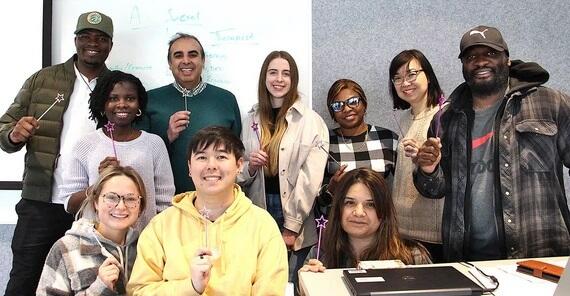Innovative Teaching Approaches
You'll be taught by faculty and instructors who are thought leaders in their field or experienced clinicians or practitioners. Here's a snap-shot of a few.
Simulations allow students to practice clinical skills safely
The young mother tentatively opens the door. She seems brittle and tense, and the deep circles under her eyes underline her tiredness. You're the social worker assigned to check in on her. What do you do? What do you say?
For social work students, suddenly being put in a real-life situation like this might be terrifying. A new approach from Dr. Angelique Jenney, the Wood's Homes Research Chair in Children's Mental Health, looks to keep some of that tension and leverage it in experiential learning.
Dr. Jenney is leading the creation of a series of videos that use a familiar video game-like approach, in which students view a situation and choose what they would do next from a list of choices. The social worker in the video then performs that action and students can observe what happens.
Dr. Jenney has used various types of simulation in her teaching for more than ten years because they provide a realistic moment in which students can have experience that mirrors real life – but in a safe environment.
Following the simulation they have a safe moment to discuss all the different ways this interaction could go in practice. The goal isn't to teach students "the right way" to handle a situation, Jenny
explains.
The goal isn't to teach students "the right way" to handle a situation, Jenny explains. In fact, it’s the opposite. The goal is to show that there really isn’t a “right” answer. She instead emphasizes a collaborative approach to find the best way to help, in that moment.
"I want them to understand what collaborative practice looks like," Dr. Jenney says. "It's not about 'the social worker is the expert.' The client is the expert in their own lives. We're simply facilitators and walk alongside them in a way, witnessing that experience with them."
Dr. Jenney's simulation draws on her extensive experience as a front-line clinician, as well as her research in which she recorded how experienced clinicians experienced a therapeutic simulation exercise and then worked with them to identify the approaches they were using (and why) to develop best-practice approaches.

An innovative "choose your own adventure" video teaching tool, allows students to practice making decisions in a safe environment.

Lateef Habib (2nd row, 2nd from left) and students pose with their magic wands. The miracle question can sometimes be an effective approach in therapy.
Zoltan Varadi
Inspiring students with magic wands and miracle questions
Lateef Habib likes to gift his students a magic wand. To be clear, Habib isn't a character from a Harry Potter film. He teaches at the University of Calgary, Faculty of Social Work, not Hogwarts. The wands are from the dollar store, but that doesn't make the magic he practises as a clinical social worker and teacher any less real.
"I give them the magic wand because I practise solution-focused therapy," explains Habib, MSW, RSW, who is a registered clinical social worker (RCSW) and clinical supervisor with Alberta Health Services (AHS), an adjunct professor (field education), faculty field instructor, and sessional instructor with the Faculty of Social Work.
In solution-focused therapy, the wand goes with a miracle question. A question that can change the trajectory of a person's life: If you could wake up the next morning, and your life was changed, what would that look like? What would you want to see?
